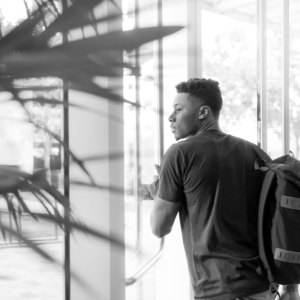Supporting Students in Online Learning
HIGHLIGHTS
- Online education—done well—holds tremendous potential for both students and universities. Yet, as with any college experience, many students still struggle to succeed and persist on their pathway to a degree.
- There’s a big opportunity for behavioral science to identify and design for barriers specific to online learning environments, particularly as more colleges are recognizing the need for (and value of) remote learning.
- We worked with Southern New Hampshire University (SNHU) to develop behavioral solutions to student persistence in online learning.
The Challenge
Online education—done well—holds tremendous potential for both students and universities. It can make college accessible to more students, including those who might live far from campus, have children at home, or need to work during traditional school hours. It can be designed in a way that frees up faculty and staff time for those high-impact engagements that foster student success. And it can be less expensive for schools and students alike, allowing scarce resources to go to other priorities.
Southern New Hampshire University (SNHU) has long been a pioneer in online education, having offered its first online courses as far back as 1995. With one of the largest online programs in the country, SNHU has significant experience supporting online students as they enroll in, persist through, and graduate from college.
And while SNHU has worked hard to increase access to high-quality degrees using a variety of approaches—including lowering tuition, providing mental health resources, and offering personalized advising through a student’s academic journey—university officials wanted to know what else they could do to support student persistence in online learning, with a particular focus on the first few terms.
Our Approach
We partnered with SNHU to learn more about why students were withdrawing and what was getting in their way. We first analyzed previous research that SNHU had conducted on student persistence and satisfaction. Next, we interviewed current (and also recently withdrawn) SNHU students, as well as instructors and advisors to learn about the greatest barriers to maintaining enrollment throughout the first few terms. We found six key factors that made students likely to withdraw:
- Encountering challenges early in the term
- Feeling that dropping out is an appropriate response to poor academic performance
- Frustrating interactions with instructors
- Not seeing the connection between general education requirements and longer-term goals
- Feeling isolated from other students, faculty, and staff
- Failing to connect with advisors at key times
To address these barriers, we explored the potential of dozens of behaviorally informed designs, ultimately focusing on the following three solutions:
Core Behavioral Insight |
Solution |
||
| It’s important to have multiple, light-touch ways of checking in so that students receive support at the moments when they need it most. Students often don’t proactively reach out for help, and it can be easy for their struggles to go unnoticed when they aren’t physically surrounded by other students, faculty, and staff. | Temperature Check embeds an interface for repeated, light-touch check-ins into advisors’ web dashboards, where advisors observe key information for all students on their caseload. This helps advisors spot struggling students before it’s too late. | ||
| It takes a long time to complete a degree, and providing shorter-term rewards can help students stay motivated and engaged. These rewards might be especially valuable for students who don’t have access to the social and emotional rewards of being in a classroom and building social connections. | Strong Start Rewards program through which students earn points for each assignment submitted. These points can be redeemed for rewards (such as swag or textbook credits) as encouragement to persist through their first few terms. | ||
| Students, particularly ones with work or family obligations outside of the classroom, often struggle to balance competing commitments. The more colleges can offer slack to accommodate those moments when “life happens,” the more students will be likely to persist through challenges and succeed. | One Late Pass per course, allowing students to submit an assignment up to one week late with no penalties and no questions asked. | ||
Takeaway
Online learning can create a big opportunity for more students to access higher education, but it also introduces new challenges for students facing all the demands of college without the social support that comes with in-person learning. Behavioral science can help identify and address barriers specific to online learning environments.
SNHU will be refining and potentially piloting some of our proposed solutions through 2022 with the goal of evaluating their impact on student persistence. While these solutions were designed specifically for SNHU’s context, many of the core components would likely apply to other online learning environments as well.
Remote education isn’t going anywhere, and applying behavioral insights like these is needed to support students as they navigate online learning environments. Both college and the world surrounding it have changed, and schools should not underestimate the need to adapt to students’ changing needs as they enroll in, persist through, and graduate from this new context.
Follow @ideas42 on Twitter to learn more about our work. Contact us at education@ideas42.org with questions.
Partners










